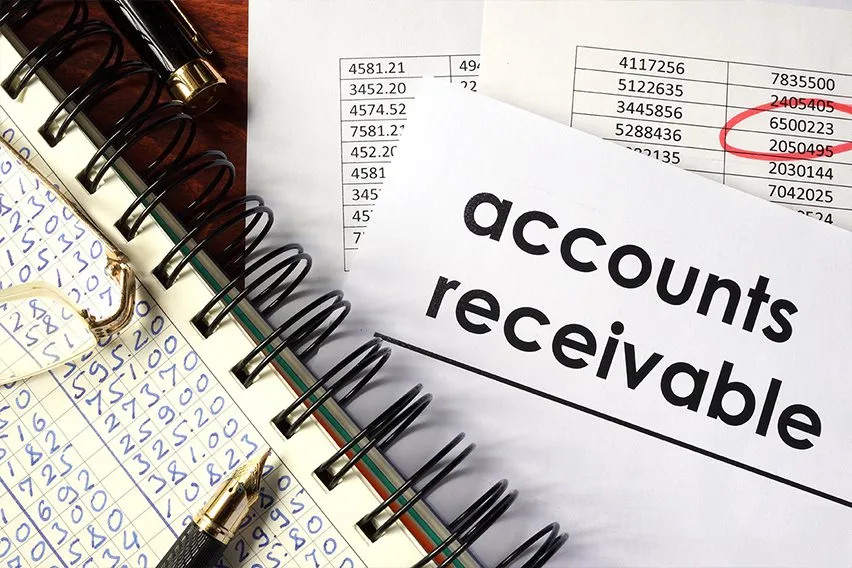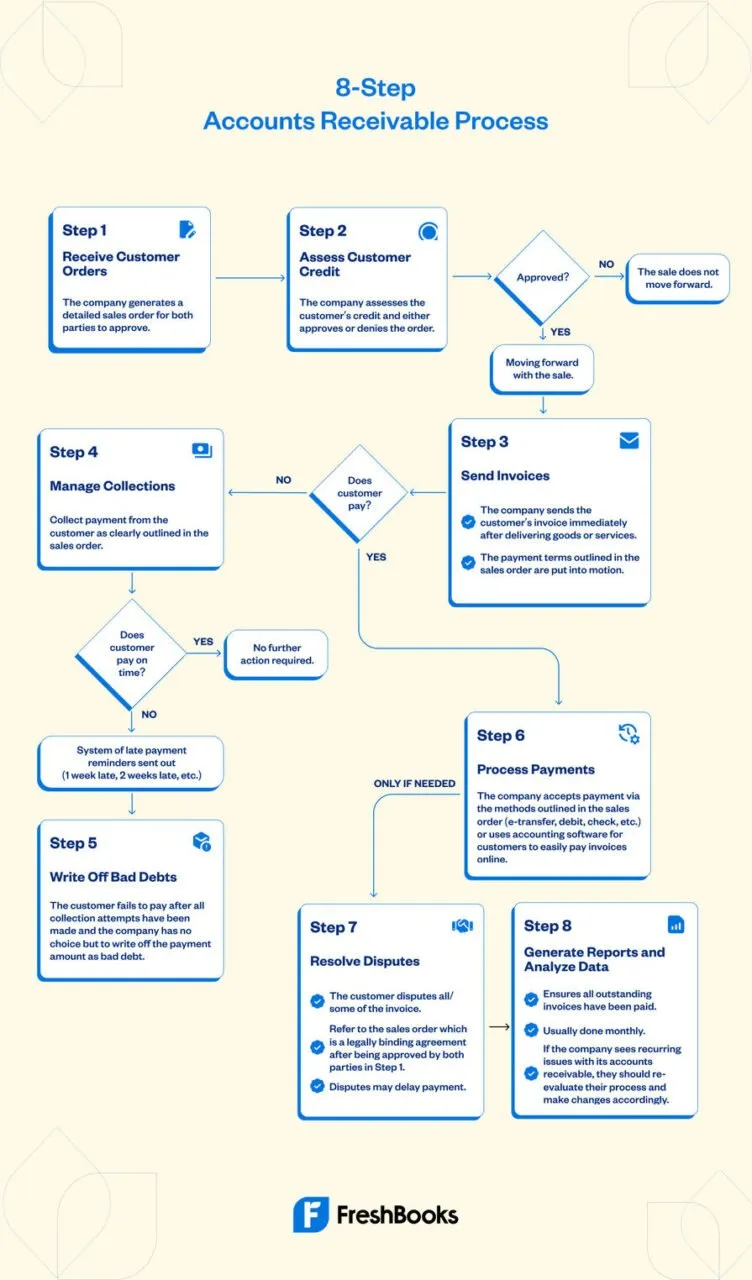Accounts Receivable Process: Step-By-Step Guide

Accounts Receivable (AR) is the money that customers owe to a business for goods or services provided. When customers make a purchase on credit, that debt is added to the business’s Accounts Receivable.
Having a clear Accounts Receivable process helps businesses assess customer credibility, track payments and collect on debts. It’s also important for generating financial data and assessing the business’s efficiency.
We’ll explore Accounts Receivable and the steps in the Accounts Receivable process. We’ll also look at key performance indicators and automation options to help you streamline your Accounts Receivable system.
Key Takeaways
- Accounts Receivable (AR) is the amount customers owe a business for goods or services provided.
- Having a good Accounts Receivable process ensures payments are collected efficiently.
- Performance metrics like cash reconciliation and Day Sales Outstanding can measure AR efficiency.
- Automating parts of the AR process can improve efficiency, accuracy, and scalability.
Table of Contents
- What Is Accounts Receivable?
- What Is The Accounts Receivable Process?
- Why Is the Accounts Receivable Process Important?
- 8-Step Accounts Receivable Process
- Key Performance Metrics for Effective Accounts Receivable Procedures
- Traditional vs Modern Accounts Receivable
- Accounts Receivable Automation
- Enhance Efficiency and Optimize Accounts Receivable Procedures
What Is Accounts Receivable?
Accounts Receivable, or AR, is the record of funds that customers owe to a business for goods or services rendered. Any time a company has provided goods or services and the customer has purchased on credit or has an account still owing, this is considered the company’s Accounts Receivable.
On a business’s balance sheet, Accounts Receivable is recorded as a current asset. These amounts are considered due in the short term, so it’s assumed that customers will be paying soon. As the goods or services have already been provided under specific terms, the debts in Accounts Receivable are legally binding. Since the funds are legally due to the business and can be used as collateral for loans, the money owed in Accounts Receivable is considered a liquid asset.

What Is the Accounts Receivable Process?
The Accounts Receivable process is the set of steps a business follows to invoice a client and collect payment. It’s essential for managing a smooth transition from sales to revenue and ensuring that a business maintains a healthy cash flow.
The Accounts Receivable cycle includes steps from order placement and approval to invoicing and collection, finishing with payment processing and reporting. It also includes steps for addressing bad debts and disputes if the customer should challenge their bill or refuse to pay.
Having a clear Accounts Receivable process and an effective accounting system are essential for promoting business growth. It helps ensure that credible customers are approved, invoices are sent on time, and incoming payments are processed and collected for regular cash flow.
Why Is the Accounts Receivable Process Important?
The Accounts Receivable process is important because it allows businesses to accurately track and collect customer payments. This ensures that cash flow remains steady and that no unpaid invoices get missed.
This process is also valuable because it encourages businesses to assess potential customers and build a credible customer base. Although businesses have the option to write off uncollectible debt, it’s still better to select customers with a proven track record of positive debt repayment. The customer credit assessment step helps businesses choose customers who are more likely to pay reliably and on time.
8-Step Accounts Receivable Process
Now that you know what a successful Accounts Receivable process is and why it’s valuable, you might be wondering how to get started. The 8 steps outlined below provide a foundation for creating a simple and effective Accounts Receivable process.

Step 1: Receive Customer Orders
To begin the ordering and Accounts Receivable process, a customer will place an order that needs to be approved by the business. Once the company receives and approves this order, it generates a sales order which includes details about quantity, price, payment date, and any other relevant terms of sale. If both parties approve the sales order, it becomes a binding agreement.
Step 2: Assess Credit
Before delivering any goods or services, it’s essential to make sure the customer is credible. This is particularly important for large orders with a high value. Businesses can also assess a customer’s payment history to check for credibility.
Once the business assesses the customer’s credit, they have the option to approve or deny their order. They can also choose to offer different payment options if credit is denied. For recurring customers, some businesses choose to waive this step if they have a trusted relationship with the customer.
Step 3: Send Invoices
It’s generally considered best practice to send invoices immediately after goods or services have been rendered. This ensures the order and payment are fresh in the customer’s mind. It also begins the payment terms outlined in the sales order, which encourages the customer to pay more quickly. Automating your invoice process can help guarantee prompt and accurate invoicing.
Step 4: Manage Collections
Many customers will pay promptly, but some may run late. Having a clear process for managing overdue payment collections ensures that you have the proper documentation if you need to seek formal collections support.
Set up a system of late payment reminders on a set schedule—for example, reminders for 1 week, 2 weeks, and 3 weeks past due. It’s best to send a gentle reminder for the earliest contact and then include more formal documentation if the customer continues to ignore payment.
In cases where the customer refuses all contact and payment, a business may choose to sell the debt to a collections agency as a last resort.
Step 5: Write Off Bad Debts
In cases where all attempts at collection management fail, a business may have no choice but to write off the bad debt. It’s helpful to have an established timeline for when your company considers unpaid invoices to become bad debt.
If you find that customers are regularly late with their payments, you may choose to extend the length of time before you write off unpaid invoices as bad debt.
Step 6: Process Payments
There are a variety of commonly accepted payments for small businesses, including e-transfer, ACH, credit, debit, check, and online payments. Your business may choose to accept some or all of these payment methods as outlined in your sales order and invoice.
For most of these methods, businesses will need a merchant account and in many cases a payment processor. You may also choose to use accounting software like FreshBooks that integrates with payment processors so customers have an easy way to pay their invoices online. Offering several easily accessible payment options can help reduce the likelihood of late or unpaid invoices.
Step 7: Resolve Disputes
In some cases, a customer may dispute part or all of an invoice. If your invoice matches the agreed-upon terms in the sales order, you should have a legally binding agreement. Disputes can still delay payment and cause cash flow issues for your business.
It’s a good practice to initiate dispute resolution promptly if any issues arise. This helps maintain positive customer relationships and increases the chances of invoice payment.
Step 8: Generate Reports and Analyze Data
After a business collects payments, it’s time to generate financial reports and analyze the data you’ve collected. Regularly reviewing these reports helps ensure that all outstanding invoices are accounted for and that no unpaid debts have gone missing.
Most businesses produce reports on a monthly basis. This helps assess the efficacy of your Accounts Receivable process and provides an overview of your revenues for the month. Frequently reviewing and analyzing financial data is also important for re-assessing any strategies that need to be improved.
Accounts Receivable Process Example
We’ll go through an example of a company’s Accounts Receivable process:
Company A sells lawnmowers at a unit price of $150 per lawnmower. Company B is a large retailer who wants to place an order for lawnmowers.
Step 1: Company B places an order for 200 lawnmowers. Company A approves this sales order for 200 lawnmowers at $150 each, plus a delivery charge of $50.
Step 2: Company A assesses Company B’s credit history and approves its credit application process to purchase the lawnmowers on credit. They fill the order and deliver the lawnmowers.
Step 3: After delivering the lawnmowers, Company A sends Company B an invoice for the lawnmowers and delivery charge. The invoice gives Company B 30 days to pay their debt.
Step 4: It is a week past the payment due date. Company A sends Company B a polite payment reminder.
At this point, Company B chooses to dispute the $50 delivery charge. Company A promptly brings in a mediator, who reminds Company B that the delivery charge was outlined on the sales order. They agree to pay and the dispute is resolved.
Step 5: Company B pays its debt, so there is no need for Company A to write it off.
Step 6: Company A processes Company B’s online payment. It is successfully deposited in the merchant account.
Step 7: The delivery charge dispute was addressed promptly, so there is no need for further action.
Step 8: Company A includes this payment in its financial report. They determine that their Accounts Receivable process is functioning well and choose to make no changes.
Key Performance Metrics for Effective Accounts Receivable Procedures
The following metrics are effective indicators for assessing how well a business runs its Accounts Receivable process. Tracking these metrics can help companies find areas to improve their assessment and collection processes.
Prompt Invoicing
Invoicing is an essential step in your Accounts Receivable process flow. It sets in motion the payment process and outlines payment terms, encouraging customers to promptly pay their debts. Ensuring you send invoices promptly sets a strong foundation for the rest of the Accounts Receivable system to proceed.
Cash Reconciliation
Cash reconciliation, or effective record-keeping, is important for generating accurate financial records and ensuring all payments are resolved. Promptly recording all transactions makes it easier to track any unpaid invoices and keep all financial records up to date.
Good cash reconciliation can also improve a business’s customer relations. In the event of a dispute, having accurate records can back up your claims and help resolve disputes quickly and effectively.
Automation and Scalability
As your business grows, the volume of Accounts Receivable payments that you process will increase. Establish a system that can grow seamlessly alongside your business. Automating aspects of your accounts receivable—such as invoicing and late payment reminders—frees up time and energy to focus on other aspects of your business.
Effective automation tools not only support scalability but can also improve accuracy and efficiency in your billing process.
Collections Efficiency Indicator
A Collections Efficiency Indicator (CEI) relates the number of successfully collected debts to the number of total debts. A high CEI rating indicates that a business’s Accounts Receivable process is effective in collecting customer payments.
CEI is an important metric for demonstrating that a business can maintain a seamless cash flow process. It also indicates that your customer credit assessment is effective since you have a high ratio of paid invoices to total invoices.
Days Sales Outstanding
Day Sales Outstanding, or DSO, measures the time it takes your Accounts Receivable team to collect an invoice payment. It’s a valuable indicator for assessing the efficiency of your collections process and the credibility of your customers.
A low DSO means that customers are paying promptly after receiving their invoices and that your team is quickly processing the payments. This correlates to good cash flow and lower amounts of bad debt write-offs.
Number of Accounts Receivable Open
Accounts Receivable Open, or AR Open, measures how many ongoing Accounts Receivable a business has in a given period. Closing Accounts Receivable translates to more payments being resolved; having Accounts Receivable remain open indicates ongoing disputes, unpaid invoices, or attempts to resolve bad debt.
The goal is to have a lower percentage of Accounts Receivable remain open. Tracking this metric can help businesses assess areas where it can improve its Accounts Receivable process.
Traditional vs. Modern Accounts Receivable
Compare traditional and modern Accounts Receivable tools to see how automating your Accounts Receivable processes can increase accuracy and efficiency.
| Traditional AR | Modern AR | |
| Invoice Generation | Manual invoice creation—time-consuming and inefficient | Automated invoice generation—prompt and accurate |
| Collections | Must manually track overdue payments | Automated late payment tracking and notifications |
| Payment Processing | Risk of errors and delays with manual entry | Automated payment processing and online options |
| Record-Keeping | Time-consuming and may require bookkeeping experience | Real-time automated recording, easy to share with cloud-based software |
| Scalability | Requires additional team members, becomes more costly | Easy digital scalability |
| Accuracy | Potential for errors with manual input | Automatically detect and quickly resolve errors |
| Data Security and Compliance | Minimal security, risk of non-compliance | High data security, regular compliance updates |
| Generating Reports | Laborious manual report generation | Automated report generation and access to advanced analytics |
| Customer Experience | Requires team members to manually address all issues | Prompt, options for self-serve tools to enhance customer experience |
Accounts Receivable Automation
Automation tools offer an affordable way to increase the accuracy and efficiency of your Accounts Receivable process. Some ways that automation can streamline your Accounts Receivable process include:
- Automatically generating invoices
- Tracking overdue payments
- Sending late payment reminders
- Digitizing payment processing
- Maintaining data security
- Updating for compliance regulations
- Generating financial statements, reports, and analytics
- Offering self-serve tools for customer support
Automating aspects like invoice generation, payment processing, and late payment reminders makes it easy to maintain a prompt and consistent AR process. This improves the likelihood of payment and enhances the customer experience.
AR automation also offers an easy way to scale your business. You can effectively manage increased orders and payment processing through online tools, while self-serve options can reduce the need for additional customer support members.
Automating your Accounts Receivable increases accuracy and efficiency, saving your business time and money while improving the customer experience.

Enhance Efficiency and Optimize Accounts Receivable Procedures
Accounts Receivable is the amount a business holds in ongoing customer debts. An efficient Accounts Receivable process is key to ensuring good cash flow, maintaining positive customer relations, and collecting payments.
Automating your Accounts Receivable process can improve efficiency and accuracy. FreshBooks accounting software offers an easy way to automate key aspects like invoice generation, late payment notifications, and payment processing. Try FreshBooks free to discover how the right accounting software can help you streamline your Accounts Receivable workflow today.
Reviewed by
Jami Gong is a Chartered Professional Account and Financial System Consultant. She holds a Masters Degree in Professional Accounting from the University of New South Wales. Her areas of expertise include accounting system and enterprise resource planning implementations, as well as accounting business process improvement and workflow design. Jami has collaborated with clients large and small in the technology, financial, and post-secondary fields.
RELATED ARTICLES



 Cash Inflow vs Outflow: What’s the Difference?
Cash Inflow vs Outflow: What’s the Difference? What Is ARN Number & How to Track Transactions?
What Is ARN Number & How to Track Transactions? 4 Best Fixed Assets Software for Accounting Management
4 Best Fixed Assets Software for Accounting Management How to Calculate EOQ (Economic Order Quantity)
How to Calculate EOQ (Economic Order Quantity) Small Business Bookkeeping: A Beginner’s Guide (2025)
Small Business Bookkeeping: A Beginner’s Guide (2025) Budgeting vs. Forecasting: What’s the Difference Between the Two?
Budgeting vs. Forecasting: What’s the Difference Between the Two?